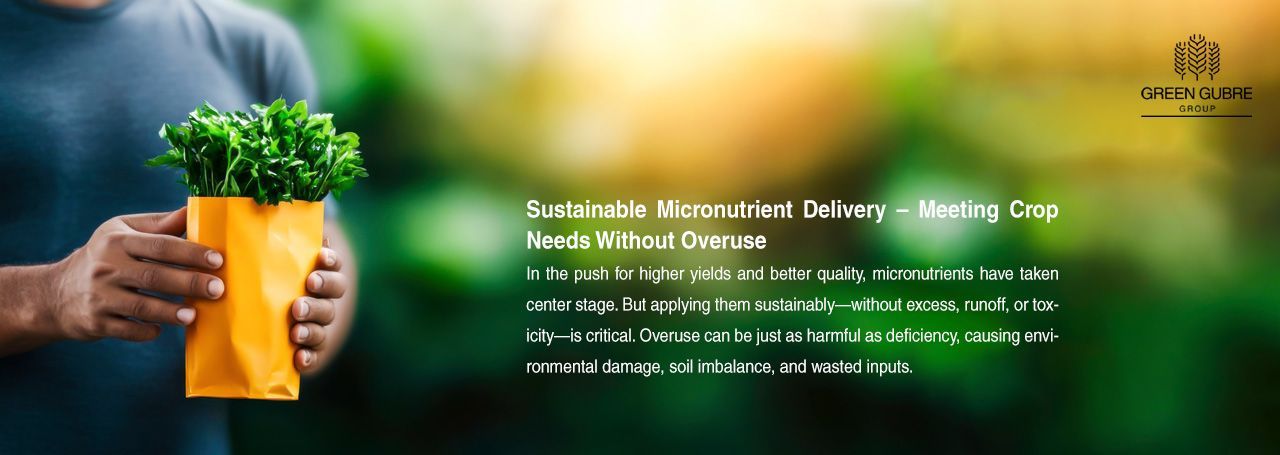Sustainable Micronutrient Delivery – Meeting Crop Needs Without Overuse
Sustainable Micronutrient Delivery – Meeting Crop Needs Without Overuse

Introduction: Micronutrients Matter – But So Does Balance
In the push for higher yields and better quality, micronutrients have taken center stage. But applying them sustainably—without excess, runoff, or toxicity—is critical. Overuse can be just as harmful as deficiency, causing environmental damage, soil imbalance, and wasted inputs.
Sustainable micronutrient delivery focuses on precision, efficiency, and synergy with plant physiology. It’s about delivering just the right amount, in the proper form, at the right time. With growing pressure to reduce environmental footprints and comply with trace element regulations, sustainable delivery methods are more important than ever.
Source – FAO – Micronutrient Management in Sustainable Agriculture
Why Sustainability Matters in Micronutrient Application
Unlike nitrogen or potassium, micronutrients are needed in tiny amounts—but mismanagement can still lead to:
- Accumulation and toxicity in soil or groundwater
- Crop imbalances that reduce the uptake of other nutrients
- Environmental harm to soil microbiota and water ecosystems
- Wasted economic investment through inefficiency or runoff
Modern agriculture needs smarter—not heavier—application methods.
Source – ScienceDirect – Micronutrient Efficiency and Environmental Impact
Innovative Forms of Sustainable Micronutrient Delivery
| Form | Description | Benefit |
|---|---|---|
| Chelated Micronutrients | Chelates (e.g., EDTA, DTPA, EDDHA) stabilize metals for better solubility | Reduce fixation in soil, increase uptake |
| Slow-Release Coatings | Polymer-coated granules or encapsulated liquids | Minimize leaching and runoff |
| Foliar Sprays | Direct application to leaves during peak demand | Precision correction with minimal waste |
| Nano-Micronutrients | Ultra-small particles enhance penetration and absorption | Lower dose, higher effect |
| Bioavailable Organic Complexes | Combined with amino acids or fulvic acid | Safer for soil and beneficial microbes |
Crop-Specific Targeting Improves Efficiency
Different crops have different sensitivities to micronutrients, and sustainable programs match delivery to actual need:
- Rice & Wheat → Zinc and iron, early root development
- Citrus & Grapes → Iron, boron, manganese for fruit quality
- Soybean & Chickpea → Molybdenum and boron for nodulation and flowering
- Tomato & Pepper → Calcium and boron during fruit set
- Sugarcane & Banana → Magnesium and copper for photosynthesis and sugar translocation
Customized application saves resources while maximizing results.
Precision Application = Sustainable Delivery
Sustainable micronutrient programs rely on the following best practices:
- Tissue and soil testing before application
- Split dosing or fertigation instead of a one-time bulk application
- Localized banding near root zones to avoid wastage
- Compatibility checks to prevent precipitates or antagonism
- Real-time monitoring through SAP testing or remote sensing
These strategies ensure nutrients reach the crop—not the environment.
Source – CropLife – Micronutrient Fertilizer Efficiency Guidelines
Green Gubre Group’s Sustainable Micronutrient Solutions
Our portfolio supports eco-efficient micronutrient use through:
- Chelated micronutrient blends (Zn, Fe, Mn, Cu, B, Mo)
- Nano-formulated foliar sprays for rapid absorption
- Organic micronutrient complexes for bioavailability and soil health
- Smart-release granules for low-loss field delivery
- Custom micronutrient enrichment in NPK blends
With our data-driven agronomic tools, we help farmers match the right micronutrient with the right strategy—avoiding overuse while boosting returns.
Conclusion: Efficiency Is the New Abundance
Sustainable micronutrient delivery is about more than just yield—it’s about precision, safety, and long-term resilience. When managed wisely, even the smallest elements can drive significant gains without harming the environment.
At Green Gubre Group, we believe smarter delivery is the future of responsible agriculture.




